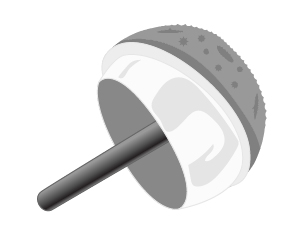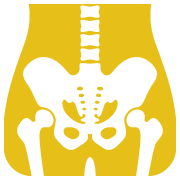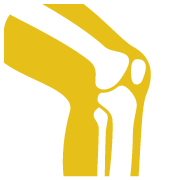BIRMINGHAM HIP Resurfacing
An Alternative to Total Hip Replacement
Younger active male patients who suffer from hip pain due to non-inflammatory arthritis (degenerative joint disease) such as osteoarthritis, traumatic arthritis, avascular necrosis, or dysplasia/DDH, or inflammatory arthritis such as rheumatoid arthritis, may benefit from the bone-conserving approach of the BIRMINGHAM HIP Resurfacing System (BHR). Unlike total hip replacement, which removes all of the bone within your ball and socket hip joint, the BHR resurfaces just a few centimeters of bone, preserving more of your original joint.
Who is a Candidate for Hip Resurfacing?
Hip resurfacing is intended for younger active male patients in need of a hip replacement. The suitability of resurfacing as an appropriate treatment for you should be determined by your surgeon, including by a review of your bone quality and the size of your femoral head. Please discuss your options with your surgeon.
About the Implant
The BHR was CE marked in January 1997 and has been implanted in hospitals in Europe since then. It was approved for use in the United States by the Food and Drug Administration in 2006.
The BHR has two parts: the femoral head (the ball) and the acetabular component (the socket).
The benefits of the BHR technique and implant for appropriate patients may be significant. The implant’s head size, its bearing surfaces and its bone-sparing technique could make it the right choice for active patients. In fact, the implant’s rate of survivorship for men under the age of 65 is comparable to – and in many cases, better than – standard total hip replacements after ten years of use1. While the implant closely matches the size of your natural femoral head (hip ball), it is substantially larger than the femoral head of most total hip replacements. This increased size helps to reduce the risk of dislocation of the implant after surgery2.
Bone Conservation Benefits
The BHR implant conserves substantially more bone than a total hip replacement. Since it preserves the natural femoral neck and most of the natural femoral head, a well-placed BHR reduces concerns about post-operative leg length discrepancy. Also, should you need the implant to be replaced at some point in the future, you would be a candidate for a standard hip replacement stem as opposed to needing a longer “revision” stem-type, as is often the case when a traditional total hip replacement needs to be replaced.
Procedure and Recovery
Total hip replacement requires the removal of the natural femoral head and the insertion of a hip stem down the shaft of the femur. Hip resurfacing, by contrast, preserves both the femoral head and the femoral neck.
During the procedure, your surgeon will only remove a few centimeters of bone around the femoral head, shaping it to fit tightly inside the BHR implant. Your surgeon will also prepare the acetabulum for the metal cup that will form the socket portion of the ball-and-socket joint.
The femoral component is cemented over the top of the prepared femoral head like a tooth cap, and the acetabular component is pressed into place much like a typical hip replacement component would be.
Why BIRMINGHAM HIP Resurfacing?
Long-term successful outcomes around the globe:
- The Australian Orthopaedic Association National Joint Replacement Registry Annual Report 20153 showed BHR survivorship of 90.2% at 14 years follow-up, the longest of any resurfacing device.
- BHR continues to be the most implanted resurfacing device world-wide and is the only hip resurfacing device with 14 years of registry data.
- Great Britain’s Oswestry Outcomes Centre’s patient registry revealed BHR 10-year survivorship of 95.4%, with 98.6% of patients rating their opinion of the experience as pleased or extremely pleased4.
References
- Data on file, Smith & Nephew.
- S. S. Jameson, D. Lees, P. James, Serrano-Pedraza, P. F. Partington, S. D. Muller, R. M. D. Meek, M. R. Reed. Lower rates of dislocation with increased femoral head size after primary total hip replacement. J Bone Joint Surg 2011;93-B:876-80.
- Australian Orthopaedic Association National Joint Replacement Registry Annual Report. Adelaide: AOA; 2015.
- Robinson E, Richardson JB, Khan M. MINIMUM 10 YEAR OUTCOME OF BIRMINGHAM HIP RESURFACING (BHR), A REVIEW OF 518 CASES FROM AN INTERNATIONAL REGISTER. Oswestry Outcome Centre, Oswestry, UK.
About Dr. Gough
Dr. Gough is a board certified member of the American Board of Orthopaedic Surgeons; member of the American Academy of Orthopaedic Surgeons (AAOS); Vice President of the Orthopaedic Surgery Interest Group; and is a member of the American Medical Association and American College of Physicians. Dr. Gough’s private orthopaedic practice is located within the prestigious Orthopaedic Institute of the West, which he helped create, and he has operating privileges at Scottsdale Abrazo Hospital, Liberty Hospital and a few surgery centers located in the Phoenix/Scottsdale, AZ area.
HIP PROCEDURES
Dr. Gough offers a variety of advanced solutions to degenerative hip problems
KNEE PROCEDURES
Dr. Gough offers a variety of advanced solutions to degenerative knee problems



